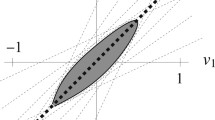Abstract
Since the organism contains many redundant reactions, the minimal feasible metabolic network that contains the basic growth function is not the collection of reactions that associate the essential genes. To identify minimal metabolic reaction set is a challenging work in theoretical approach. A new method is presented here to identify the smallest required reaction set of growth-sustaining metabolic networks. The content and number of the minimal reactions for growth are variable in different random processes. Though the different carbon sources also vary the content of the reactions in the minimal metabolic networks, most essential reactions locate in the same metabolic subsystems, such as cofactor and prosthetic group biosynthesis, cell envelope biosynthesis, and membrane lipid metabolism.






Similar content being viewed by others
References
Jeong, H., Tombor, B., Albert, R., Oltvai, Z. N., & Barabási, A. L. (2000). The large-scale organization of metabolic networks. Nature, 407, 651–654. doi:10.1038/35036627.
Sharan, R., & Ideker, T. (2006). Modeling cellular machinery through biological network comparison. Nature Biotechnology, 24, 427–433. doi:10.1038/nbt1196.
Becker, D., Selbach, M., Rollenhagen, C., Ballmaier, M., Meyer, T. F., Mann, M., et al. (2006). Robust Salmonella metabolism limits possibilities for new antimicrobials. Nature, 440, 303–307. doi:10.1038/nature04616.
Schuster, S., Fell, D. A., & Dandekar, T. (2000). A general definition of metabolic pathways useful for systematic organization and analysis of complex metabolic networks. Nature Biotechnology, 18, 326–332. doi:10.1038/73786.
Burgard, A. P., Vaidyaraman, S., & Maranas, C. D. (2001). Minimal reaction sets for Escherichia coli metabolism under different growth requirements and uptake environments. Biotechnology Progress, 17, 791–797. doi:10.1021/bp0100880.
Pal, C., Papp, B., Lercher, M. J., Csermely, P., Oliver, S. G., & Hurst, L. D. (2006). Chance and necessity in the evolution of minimal metabolic networks. Nature, 440, 667–670. doi:10.1038/nature04568.
Kauffman, K. J., Prakash, P., & Edwards, J. S. (2003). Advances in flux balance analysis. Current Opinion in Biotechnology, 14, 491–496. doi:10.1016/j.copbio.2003.08.001.
Lee, J. M., Gianchandani, E. P., & Papin, J. A. (2006). Flux balance analysis in the era of metabolomics. Briefings in Bioinformatics, 7, 140–150. doi:10.1093/bib/bbl007.
Edwards, J. S., & Palsson, B. O. (2000). The Escherichia coli MG1655 in silico metabolic genotype: Its definition, characteristics, and capabilities. Proceedings of the National Academy of Sciences of the United States of America, 97, 5528–5533. doi:10.1073/pnas.97.10.5528.
Reed, J. L., Vo, T. D., Schilling, C. H., & Palsson, B. O. (2003). An expanded genome-scale model of Escherichia coli K-12 (iJR904 GSM/GPR). Genome Biology, 4, R54. doi:10.1186/gb-2003–4–9-r54.
Feist, A. M., & Palsson, B. O. (2008). The growing scope of applications of genome-scale metabolic reconstructions using Escherichia coli. Nature Biotechnology, 26, 659–667. doi:10.1038/nbt1401.
Fong, S. S., & Palsson, B. O. (2004). Metabolic gene-deletion strains of Escherichia coli evolve to computationally predicted growth phenotypes. Nature Genetics, 36, 1056–1058. doi:10.1038/ng1432.
Fischer, E., & Sauer, U. (2005). Large-scale in vivo flux analysis shows rigidity and suboptimal performance of Bacillus subtilis metabolism. Nature Genetics, 37, 636–640. doi:10.1038/ng1555.
Schuetz, R., Kuepfer, L., & Sauer, U. (2007). Systematic evaluation of objective functions for predicting intracellular fluxes in Escherichia coli. Molecular Systems Biology, 3, 119. doi:10.1038/msb4100162.
Nielsen, J. (2007). Principles of optimal metabolic network operation. Molecular Systems Biology, 3, 126. doi:10.1038/msb4100169.
Papp, B., Pal, C., & Hurst, L. D. (2004). Metabolic network analysis of the causes and evolution of enzyme dispensability in yeast. Nature, 429, 661–664. doi:10.1038/nature02636.
Ghim, C. M., Goh, K. I., & Kahng, B. (2005). Lethality and synthetic lethality in the genome-wide metabolic network of Escherichia coli. Journal of Theoretical Biology, 237, 401–411. doi:10.1016/j.jtbi.2005.04.025.
Fell, D. A., & Wagner, A. (2000). The small world of metabolism. Nature Biotechnology, 18, 1121–1122. doi:10.1038/81025.
Wagner, A., & Fell, D. A. (2001). The small world inside large metabolic networks. Proceedings of the Royal Society of London. Series B. Biological Sciences, 268, 1803–1810. doi:10.1098/rspb.2001.1711.
Ravasz, E., Somera, A. L., Mongru, D. A., Oltvai, Z. N., & Barabási, A. L. (2002). Hierarchical organization of modularity in metabolic networks. Science, 297, 1551–1555. doi:10.1126/science.1073374.
Acknowledgments
Da Jiang, Hui Liu and Shuigeng Zhou are supported by National Natural Science Foundation of China under grant no. 60496327 and Shanghai Leading Academic Discipline Project (Project number B114).
Author information
Authors and Affiliations
Corresponding author
Rights and permissions
About this article
Cite this article
Jiang, D., Zhou, S., Liu, H. et al. Inferring Minimal Feasible Metabolic Networks of Escherichia coli . Appl Biochem Biotechnol 160, 222–231 (2010). https://doi.org/10.1007/s12010-009-8572-5
Received:
Accepted:
Published:
Issue Date:
DOI: https://doi.org/10.1007/s12010-009-8572-5




